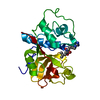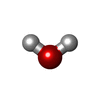[English] 日本語
 Yorodumi
Yorodumi- PDB-9nb7: Serial synchrotron X-ray diffraction structure of papain microcry... -
+ Open data
Open data
- Basic information
Basic information
| Entry | Database: PDB / ID: 9nb7 | ||||||||||||
|---|---|---|---|---|---|---|---|---|---|---|---|---|---|
| Title | Serial synchrotron X-ray diffraction structure of papain microcrystals soaked with natural product E405 | ||||||||||||
 Components Components | Papain | ||||||||||||
 Keywords Keywords | HYDROLASE / Inhibitor / Complex / Enzyme / Serial | ||||||||||||
| Function / homology |  Function and homology information Function and homology informationpapain / serpin family protein binding / cysteine-type peptidase activity / proteolysis Similarity search - Function | ||||||||||||
| Biological species |  | ||||||||||||
| Method |  X-RAY DIFFRACTION / X-RAY DIFFRACTION /  SYNCHROTRON / SYNCHROTRON /  MOLECULAR REPLACEMENT / Resolution: 1.8 Å MOLECULAR REPLACEMENT / Resolution: 1.8 Å | ||||||||||||
 Authors Authors | Vlahakis, N.W. / Summers, J.A. / Wakatsuki, S. / Rodriguez, J.A. | ||||||||||||
| Funding support |  United States, 3items United States, 3items
| ||||||||||||
 Citation Citation |  Journal: bioRxiv / Year: 2025 Journal: bioRxiv / Year: 2025Title: Combining MicroED and native mass spectrometry for structural discovery of enzyme-biosynthetic inhibitor complexes. Authors: Niko W Vlahakis / Cameron W Flowers / Mengting Liu / Matthew Agdanowski / Samuel Johnson / Jacob A Summers / Catherine Keyser / Phoebe Russell / Samuel Rose / Julien Orlans / Nima Adhami / ...Authors: Niko W Vlahakis / Cameron W Flowers / Mengting Liu / Matthew Agdanowski / Samuel Johnson / Jacob A Summers / Catherine Keyser / Phoebe Russell / Samuel Rose / Julien Orlans / Nima Adhami / Yu Chen / Michael R Sawaya / Shibom Basu / Daniele de Sanctis / Soichi Wakatsuki / Hosea M Nelson / Joseph A Loo / Yi Tang / Jose A Rodriguez /   Abstract: With the goal of accelerating the discovery of small molecule-protein complexes, we leverage fast, low-dose, event based electron counting microcrystal electron diffraction (MicroED) data collection ...With the goal of accelerating the discovery of small molecule-protein complexes, we leverage fast, low-dose, event based electron counting microcrystal electron diffraction (MicroED) data collection and native mass spectrometry. This approach resolves structures of the epoxide-based cysteine protease inhibitor, and natural product, E-64, and its biosynthetic analogs bound to the model cysteine protease, papain. The combined structural power of MicroED and the analytical capabilities of native mass spectrometry (ED-MS) allows assignment of papain structures bound to E-64-like ligands with data obtained from crystal slurries soaked with mixtures of known inhibitors, and crude biosynthetic reactions. ED-MS further discriminates the highest-affinity ligand soaked into microcrystals from a broad inhibitor cocktail, and identifies multiple similarly high-affinity ligands soaked into microcrystals simultaneously. This extends to libraries of printed ligands dispensed directly onto TEM grids and later soaked with papain microcrystal slurries. ED-MS identifies papain binding to its preferred natural products, by showing that two analogues of E-64 outcompete others in binding to papain crystals, and by detecting papain bound to E-64 and an analogue from crude biosynthetic reactions, without purification. This illustrates the utility of ED-MS for natural product ligand discovery and for structure-based screening of small molecule binders to macromolecular targets. | ||||||||||||
| History |
|
- Structure visualization
Structure visualization
| Structure viewer | Molecule:  Molmil Molmil Jmol/JSmol Jmol/JSmol |
|---|
- Downloads & links
Downloads & links
- Download
Download
| PDBx/mmCIF format |  9nb7.cif.gz 9nb7.cif.gz | 59.8 KB | Display |  PDBx/mmCIF format PDBx/mmCIF format |
|---|---|---|---|---|
| PDB format |  pdb9nb7.ent.gz pdb9nb7.ent.gz | Display |  PDB format PDB format | |
| PDBx/mmJSON format |  9nb7.json.gz 9nb7.json.gz | Tree view |  PDBx/mmJSON format PDBx/mmJSON format | |
| Others |  Other downloads Other downloads |
-Validation report
| Arichive directory |  https://data.pdbj.org/pub/pdb/validation_reports/nb/9nb7 https://data.pdbj.org/pub/pdb/validation_reports/nb/9nb7 ftp://data.pdbj.org/pub/pdb/validation_reports/nb/9nb7 ftp://data.pdbj.org/pub/pdb/validation_reports/nb/9nb7 | HTTPS FTP |
|---|
-Related structure data
| Related structure data |  9n9dC  9naeC  9nagC  9naoC  9narC  9natC  9naxC  9nayC  9nb2C  9nb4C  9nbfC  9nbjC  9nbkC  9nbnC C: citing same article ( |
|---|---|
| Similar structure data | Similarity search - Function & homology  F&H Search F&H Search |
- Links
Links
- Assembly
Assembly
| Deposited unit | 
| ||||||||
|---|---|---|---|---|---|---|---|---|---|
| 1 |
| ||||||||
| Unit cell |
|
- Components
Components
| #1: Protein | Mass: 23452.301 Da / Num. of mol.: 1 / Source method: isolated from a natural source / Source: (natural)  |
|---|---|
| #2: Chemical | ChemComp-A1BWT / ( Mass: 407.461 Da / Num. of mol.: 1 / Source method: obtained synthetically / Formula: C20H29N3O6 |
| #3: Water | ChemComp-HOH / |
| Has ligand of interest | Y |
| Has protein modification | Y |
-Experimental details
-Experiment
| Experiment | Method:  X-RAY DIFFRACTION / Number of used crystals: 1 X-RAY DIFFRACTION / Number of used crystals: 1 |
|---|
- Sample preparation
Sample preparation
| Crystal | Density Matthews: 2.25 Å3/Da / Density % sol: 45.3 % |
|---|---|
| Crystal grow | Temperature: 298 K / Method: vapor diffusion, sitting drop Details: 889 mM NaCl, 58% methanol in reservoir. 66% methanol in sitting drop |
-Data collection
| Diffraction | Mean temperature: 298 K / Serial crystal experiment: Y |
|---|---|
| Diffraction source | Source:  SYNCHROTRON / Site: SYNCHROTRON / Site:  ESRF ESRF  / Beamline: ID29 / Wavelength: 1.072 Å / Beamline: ID29 / Wavelength: 1.072 Å |
| Detector | Type: PSI JUNGFRAU 4M / Detector: PIXEL / Date: Nov 5, 2024 |
| Radiation | Protocol: SINGLE WAVELENGTH / Monochromatic (M) / Laue (L): M / Scattering type: x-ray |
| Radiation wavelength | Wavelength: 1.072 Å / Relative weight: 1 |
| Reflection | Resolution: 1.8→44.05 Å / Num. obs: 37928 / % possible obs: 100 % / Redundancy: 297.15 % / CC1/2: 0.935 / CC star: 0.983 / R split: 0.206 / Net I/σ(I): 4.6 |
| Reflection shell | Resolution: 1.8→1.83 Å / Mean I/σ(I) obs: 1.2 / Num. unique obs: 1877 / CC1/2: 0.397 / CC star: 0.754 / R split: 0.921 / % possible all: 100 |
| Serial crystallography sample delivery | Method: fixed target |
| Serial crystallography sample delivery fixed target | Description: mylar foils |
| Serial crystallography data reduction | Crystal hits: 27585 / Frames indexed: 21818 / Lattices indexed: 23401 |
- Processing
Processing
| Software |
| ||||||||||||||||||||||||||||||||||||||||||||||||||||||||
|---|---|---|---|---|---|---|---|---|---|---|---|---|---|---|---|---|---|---|---|---|---|---|---|---|---|---|---|---|---|---|---|---|---|---|---|---|---|---|---|---|---|---|---|---|---|---|---|---|---|---|---|---|---|---|---|---|---|
| Refinement | Method to determine structure:  MOLECULAR REPLACEMENT / Resolution: 1.8→44.05 Å / SU ML: 0.19 / Cross valid method: FREE R-VALUE / σ(F): 1.35 / Phase error: 21.57 / Stereochemistry target values: ML MOLECULAR REPLACEMENT / Resolution: 1.8→44.05 Å / SU ML: 0.19 / Cross valid method: FREE R-VALUE / σ(F): 1.35 / Phase error: 21.57 / Stereochemistry target values: ML
| ||||||||||||||||||||||||||||||||||||||||||||||||||||||||
| Solvent computation | Shrinkage radii: 0.9 Å / VDW probe radii: 1.1 Å / Solvent model: FLAT BULK SOLVENT MODEL | ||||||||||||||||||||||||||||||||||||||||||||||||||||||||
| Refinement step | Cycle: LAST / Resolution: 1.8→44.05 Å
| ||||||||||||||||||||||||||||||||||||||||||||||||||||||||
| Refine LS restraints |
| ||||||||||||||||||||||||||||||||||||||||||||||||||||||||
| LS refinement shell |
|
 Movie
Movie Controller
Controller


 PDBj
PDBj

